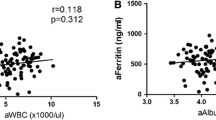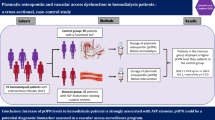Abstract
Purpose
Magnesium insufficiency is a pro-atherogenic factor involved in endothelial dysfunction, atherosclerosis, and vascular calcification. Our aim was to examine the role of magnesium in the development of arteriovenous fistula complications in hemodialysis.
Methods
This was a retrospective clinical investigation of data from 88 patients who were divided into two groups: those with and without arteriovenous fistula complications. We examined the influence of sex, demographics, and clinical and laboratory parameters. The existence of fistula stenosis was determined by measuring Doppler flow, while B-mode ultrasound was used to detect plaques and evaluate the carotid artery intima–media thickness.
Results
Patients with arteriovenous fistula complications had significantly higher leukocyte counts (p = 0.03), platelet counts (p = 0.03), phosphate concentrations (p = 0.044), and alkaline phosphatase concentrations (p = 0.04). Patients without complications had significantly greater blood flow through the arteriovenous fistula (p < 0.0005), higher magnesium concentrations (p = 0.004), and a lower carotid artery intima–media thickness (p = 0.037). The magnesium level was inversely correlated with leukocyte (p = 0.028) and platelet (p = 0.016) counts. The magnesium concentration was significantly lower in patients with carotid artery plaques (p = 0.03). Multiple linear regression, using magnesium as the dependent variable in patients with arteriovenous fistula complications, indicated statistically significant correlations with platelet (p = 0.005) and leukocyte (p = 0.027) counts and carotid plaques (p = 0.045).
Conclusions
Hypomagnesemia is a significant pro-atherogenic factor and an important predictor of arteriovenous fistula complications.
Similar content being viewed by others
References
Courivaud C, Davenport A (2013) Magnesium and the risk of all-cause and cardiac mortality in hemodialysis patients: Agent provocateur or innocent bystander? Kidney Int 85:17–20. doi:10.1038/ki.2013.301
Bonjour JP, Guéguen L, Palacios C, Shearer MJ, Weaver CM (2009) Minerals and vitamins in bone health: the potential value of dietary enhancement. Br J Nutr 101:1581–1596. doi:10.1017/S0007114509311721
Ángel LM, Francisco De, Rodriguez M, Rodríguez M (2013) Magnesium—its role in CKD. Nefrologia 33:389–399. doi:10.3265/Nefrologia.pre2013.Feb.11840 (English Version)
Kanbay M, Goldsmith D, Uyar ME, Turgut F, Covic A (2010) Magnesium in chronic kidney disease: challenges and opportunities. Blood Purif 29:280–292. doi:10.1159/000276665
Ishimura E, Okuno S, Kitatani K, Tsuchida T, Yamakawa T, Shioi A, Inaba M, Nishizawa Y (2007) Significant association between the presence of peripheral vascular calcification and lower serum magnesium in hemodialysis patients. Clin Nephrol 68:222–227. doi:10.5414/CNP68222
Meema HE, Oreopoulos DG, Rapoport A (1987) Serum magnesium level and arterial calcification in end-stage renal disease. Kidney Int 32:388–394
Massy ZA, Drüeke TB (2012) Magnesium and outcomes in patients with chronic kidney disease: focus on vascular calcification, atherosclerosis and survival. Clin Kidney J 5(Suppl 1):i52–i61. doi:10.1093/ndtplus/sfr167
Floege J (2015) Magnesium in CKD: More than a calcification inhibitor? J Nephrol 28:269–277. doi:10.1007/s40620-014-0140-6
Pakfetrat M, Sharifpour S, Malekmakan L, Jahromi SE, Roozbeh J, Aslani A (2014) The effect of magnesium oxide on hyperphosphatemia in female hemodialysis patients. Women’s Health Bull 1(2):e20048
Stolic R (2013) Most important chronic complications of arteriovenous fistulas for hemodialysis. Med Princ Pract 22:220–228. doi:10.1159/000348664
Stolić R, Trajković G, Perić V, Jovanović A, Subarić-Gorgieva G (2007) Impact of arteriosclerosis on the functioning of arteriovenous fistula for hemodialysis. Vojnosanit Pregl 64:13–18 (Serbian)
Stolić R, Mitrović S, Stolić D, Mitić N (2010) Early pathohistological changes in dysfunction of arteriovenous fistula for hemodialysis. Vojnosanit Pregl 67:65–68 (Serbian)
Papagianni A, Kalovoulos M, Kirmizis D, Vainas A, Belechri AM, Alexopoulos E, Memmos D (2003) Carotid atherosclerosis is associated with inflammation and endothelial cell adhesion molecules in chronic haemodialysis patients. Nephrol Dial Transplant 18:113–119. doi:10.1093/ndt/18.1.113
Geroulakos G, O’Gorman DJ, Kalodiki E, Sheridan DJ, Nicolaides SN (1994) The carotid intima-media thickness as a marker of the presence of severe symptomatic coronary artery disease. Eur Heart J 15:781–785
Wiese P, Nonnast-Daniel B (2004) Colour Doppler ultrasound in dialysis access. Nephrol Dial Transplant 19:1956–1963. doi:10.1093/ndt/gfh244
Sakaguchi Y, Fujii N, Shoji T, Hayashi T, Rakugi H, Isaka Y (2013) Hypomagnesemia is a significant predictor of cardiovascular and non-cardiovascular mortality in patients undergoing hemodialysis. Kidney Int 85:174–181. doi:10.1038/ki.2013.327
Maier JA (2012) Endothelial cells and magnesium: implications in atherosclerosis. Clin Sci (Lond) 122:397–407. doi:10.1042/CS20110506
Kanbay M, Yilmaz MI, Apetrii M, Saglam M, Yaman H, Unal HU et al (2012) Relationship between serum magnesium levels and cardiovascular events in chronic kidney disease patients. Am J Nephrol 36:228–237. doi:10.1159/000341868
Tzanakis I, Virvidakis K, Tsomi A, Mantakas E, Girousis N, Karefyllakis N, Papadaki A, Kallivretakis N, Mountokalakis T (2004) Intra-and extracellular magnesium levels and atheromatosis in haemodialysis patients. Magnes Res 17:102–108
Floridis J, Abeyaratne A, Majoni SW (2015) Prevalence and clinical impact of magnesium disorders in end-stage renal disease: a protocol for a systematic review. Syst Rev 4:76. doi:10.1186/s13643-015-0063-x
Ren HQ, Chen GF, Cai Q, Li Y, Han SJ, Li L (2011) Risk factors for carotid artery distensibility in middle-aged and elderly hemodialysis patients. World J Emerg Med 2:137–140. doi:10.5847/wjem.j.1920-8642.2011.02.011
Turgut F, Kanbay M, Metin MR, Uz E, Akcay A, Covic A (2008) Magnesium supplementation helps to improve carotid intima media thickness in patients on hemodialysis. Int Urol Nephrol 40:1075–1082. doi:10.1007/s11255-008-9410-3
Mortazavi M, Moeinzadeh F, Saadatnia M, Shahidi S, McGee JC, Minagar A (2013) Effect of magnesium supplementation on carotid intima-media thickness and flow-mediated dilatation among hemodialysis patients: a double-blind, randomized, placebo-controlled trial. Eur Neurol 69:309–316. doi:10.1159/000346427
Allon M, Robbin ML (2002) Increasing arteriovenous fistulas in hemodialysis patients: problems and solutions. Kidney Int 62:1109–1124. doi:10.1111/j.1523-1755.2002.kid551.x
Malovrh M (1998) Non-invasive evaluation of vessels by duplex sonography prior to construction of arteriovenous fistulas for haemodialysis. Nephrol Dial Transplant 13:125–129. doi:10.1093/ndt/13.1.125
Polkinghorne KR, Lau KKP, Saunder A, Atkins RC, Kerr PG (2006) Does monthly native arteriovenous fistula blood-flow surveillance detect significant stenosis—a randomized controlled trial. Nephrol Dial Transplant 21:2498–2506. doi:10.1093/ndt/gfl242
Disthabanchong S (2012) Vascular calcification in chronic kidney disease: pathogenesis and clinical implication. World J Nephrol 6:43–53. doi:10.5527/wjn.v1.i2.43
Geiger H, Wanner C (2012) Magnesium in disease. Clin Kidney J 5(Suppl 1):i25–i38. doi:10.1093/ndtplus/sfr165
Ortega O, Rodriguez I, Cobo G, Hinostroza J, Gallar P, Mon C, et al (2013) Lack of influence of serum magnesium levels on overall mortality and cardiovascular outcomes in patients with advanced chronic kidney disease. ISRN Nephrol. Article ID 191786. doi:10.5402/2013/191786
Nicoll R, Howard JML, Henein MY (2015) A review of the effect of diet on cardiovascular calcification. Int J Mol Sci 16:8861–8883. doi:10.3390/ijms16048861
Stolic RV, Trajkovic GZ, Kostic M, Stolic DZ, Miric DJ, Kisic BM et al (2014) Predictive value of serum myeloperoxidase activity for thrombosis of arteriovenous fistulas. Hemodial Int 18:680–685. doi:10.1111/hdi.12155
Author information
Authors and Affiliations
Corresponding author
Ethics declarations
Conflict of interest
The authors declare that they have no conflict of interest.
Ethical approval
All procedures performed in studies involving human participants were in accordance with the ethical standards of the institutional and/or national research committee and with the 1964 Helsinki declaration and its later amendments or comparable ethical standards. For this type of study (retrospective study), formal consent is not required. This article does not contain any studies with animals performed by any of the authors.
Rights and permissions
About this article
Cite this article
Stolic, R.V., Jovanovic, A.N., Trajkovic, G.Z. et al. Is low magnesium a clue to arteriovenous fistula complications in hemodialysis?. Int Urol Nephrol 48, 773–779 (2016). https://doi.org/10.1007/s11255-015-1207-6
Received:
Accepted:
Published:
Issue Date:
DOI: https://doi.org/10.1007/s11255-015-1207-6




